Determination of Milk Composition and Microbiological Properties in Goat Milk Obtained from Different Farms
DOI:
https://doi.org/10.24925/turjaf.v10i7.1281-1285.5003Keywords:
Goat, Milk, Milk content, Microbiological properties, BacteriumAbstract
Goat milk has a great importance for human nutrition considering its nutrient content. In addition, the demand for goat milk and products derived from goat milk has increased in recent years. However, the microbiological properties of milk can directly affect human health. In this study, it was aimed to determine the nutrient content and some microbiological properties of goat milk obtained from different farms. In the study, hand milking farms were determined. After milking, a sufficient amount of milk sample was taken and brought to the laboratory at +4°C. In the milk samples, the composition of the milk, the total number of aerobic mesophilic bacteria, the number of yeast-mold and coliform bacteria were determined. The highest protein, lactose and solids ratio (%) was obtained in milk samples taken from farms 2 and 4. The highest fat content in milk was determined in the sample taken from farm 4. It was observed that the milks of farms 2, 3 and 4 had similar mineral substance amounts. Total aerobic mesophilic bacteria (PCA) count (191×104), yeast-mold (PDA) count (42×103) and coliform bacteria (VRBA) count (710×102) were determined in farm 2. As a result, in terms of some milk components were determined statistical differences between farms. The main difference is in terms of milk hygiene. However, it was determined that the milk showed significant changes in terms of microbiological properties according to the farms from which they were obtained. It can also be said that these changes may affect the health of people who directly or indirectly consume these milks.Downloads
Published
30.07.2022
How to Cite
Boğa, P., Kezer, G., & Şirin, E. (2022). Determination of Milk Composition and Microbiological Properties in Goat Milk Obtained from Different Farms. Turkish Journal of Agriculture - Food Science and Technology, 10(7), 1281–1285. https://doi.org/10.24925/turjaf.v10i7.1281-1285.5003
Issue
Section
Research Paper
License
This work is licensed under a Creative Commons Attribution-NonCommercial 4.0 International License.









